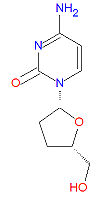Zalcitabine: Difference between revisions
Jump to navigation
Jump to search

imported>David E. Volk m (typo) |
imported>David E. Volk mNo edit summary |
||
| Line 5: | Line 5: | ||
Its IUPAC chemical name is 4-amino-1-[(2R,5S)-5-(hydroxymethyl)oxolan-2-yl]pyrimidin-2-one and it has molecular formula C<sub>9</sub>H<sub>13</sub>N<sub>3</sub>O<sub>3</sub>. | Its IUPAC chemical name is 4-amino-1-[(2R,5S)-5-(hydroxymethyl)oxolan-2-yl]pyrimidin-2-one and it has molecular formula C<sub>9</sub>H<sub>13</sub>N<sub>3</sub>O<sub>3</sub>. | ||
== External links == | |||
* {{DailyMed}} | |||
* {{MedMaster}} | |||
* {{DrugBank}} | |||
Revision as of 11:42, 5 March 2008
Zalcitabine, or Dideoxycytidine (DDC or DDCYD), is a dideoxynucleoside antiviral drug that is an analog of the natural DNA base cytosine. The lack of 3'-hydroxyl group makes it a viral DNA chain terminator. It also inhibits HIV-1 reverse transcriptase by binding to it and competing with the natural substrate deoxycytidine triphosphate (dCTP). The related drug lamivudine, which has a sulfur atom in place of the 3'-carbon present in zalcitabine.
Its IUPAC chemical name is 4-amino-1-[(2R,5S)-5-(hydroxymethyl)oxolan-2-yl]pyrimidin-2-one and it has molecular formula C9H13N3O3.
External links
- Zalcitabine - FDA approved drug information (drug label) from DailyMed (U.S. National Library of Medicine).
- Template:MedMaster
- Template:DrugBank
